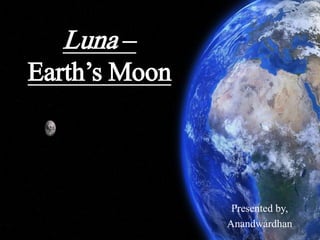
Luna – Earth’s Moon
- 1. Luna – Earth’s Moon Presented by, Anandwardhan
- 2. Luna - Earth’s Moon • The fifth largest moon in the solar system, Earth's Moon is the only place beyond Earth where humans have set foot. The Moon is the most explored body in our solar system besides Earth, having been visited by numerous spacecraft from multiple space agencies around the world. • The brightest and largest object in our night sky, the moon makes Earth a more liveable planet by moderating our home planet's wobble on its axis, leading to a relatively stable climate. It also causes tides, creating a rhythm that has guided humans for thousands of years. • Earth's only natural satellite is simply called "the Moon" because people didn't know other moons existed until Galileo Galilei discovered four moons orbiting Jupiter in 1610.
- 3. The Moon Equatorial Radius 1,737.5 km Polar Radius 1,736.0 km Mass 7.342x1022 kg Mean Density 3.344 g/cm3 Surface Gravity 1.62 m/s2 Temperature Range -248 to 123o C Distance from Earth(avg.) Perigee Apogee 384,400 km 362,600 km 405,400 km Orbital period 27 d 7 h 43 min Synodic period 29 d 12 h 44 min Near Side North Pole Far Side South Pole Water found as ICE (discovered by Chandrayaaan-1)
- 4. Formation of the Moon Early Theories Currently Acceptable Theory- “Giant Impact Theory”
- 5. Lunar Atmosphere • The moon has a very thin and weak atmosphere, called an exosphere. It does not provide any protection from high energy solar particles, cosmic rays or impacts from meteoroids. • escape velocity is too low on the Moon • - all gas molecules can escape! • no atmospheric pressure means that water can not exist in liquid form • - only in solid or vapour • no weathering of the surface by water, storm
- 6. Lunar Geological Features 1. Craters With too sparse an atmosphere to impede impacts, a steady rain of asteroids, meteoroids and comets strikes the surface of the moon, leaving numerous craters behind. Tycho Crater is more than 52 miles (85 kilometres) wide. The craters themselves, which have been preserved for billions of years, provide an impact history for the moon and other bodies in the inner solar system. 2. Regolith Over billions of years, impacts have ground up the surface of the moon into fragments ranging from huge boulders to powder. Nearly the entire moon is covered by a rubble pile of charcoal-gray, powdery dust and rocky debris called the lunar regolith. Beneath is a region of fractured bedrock referred to as the megaregolith.
- 7. Lunar Geological Features 3. Lunar Highlands or Terra The light areas of the moon are known as the highlands. Most of moon (85%) is actually covered with lighter, higher land: Highlands Rich in calcium and aluminium silicates Less dense than mare rocks and considerable older(4-4.4 billion years) Predominantly on the side of the Moon facing away from Earth 4. Lunar “Maria” (sing.-Mare)- dark, smooth regions The dark features, called Maria (Latin for seas), are impact basins that were filled with lava between 4.2 and 1.2 billion years ago. Relatively ‘low’ compared to highlands on moon; 2-5 km below other parts . Made of Basalt, rich in iron, magnesium and titanium silicates
- 8. Inner Structure of the Moon • iron-rich core like Earth • asthenosphere layer: somewhat pliable “plastic” layer • solid layer just below surface – no plate tectonics • smaller planet than Earth – less internal energy, less geological activity! • crust is thicker on non-Earth facing side • moon probably had a weak magnetic field early in history • - core is now solid, so no current is generated
- 9. Phases of Moon and Tides
- 10. Orbit of the Moon
- 11. Solar & Lunar Eclipse • Penumbral lunar eclipse—the Moon only passes through the penumbra of Earth’s shadow • Partial lunar eclipse—part of the Moon passes through the umbra of Earth’s shadow • Total lunar eclipse—the entire Moon passes through the umbra of Earth’s shadow • Annular solar eclipse—When the Moon is too far to completely cover the Sun—the umbra doesn’t reach the Earth • Partial solar eclipse—Those in “penumbra” see a partial eclipse—not safe to look directly at Sun • Total solar eclipse—Observers in the “umbra” shadow see a total eclipse (safe to view the Sun); can see the corona
- 12. THANK YOU